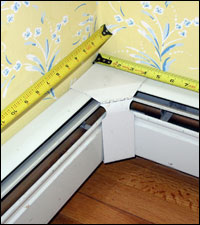In this presentation, Gary Klein shares important information about air source heat pump water heaters (HPWH), with particular attention paid to where the warm air comes ...
Don't Size a Hot-Water Boiler By Measuring the Radiators

They built our house in 1950 here on the Isle of Long and it used to have a radiant heating system.
In 1970, the previous owner noticed wet spots on his kitchen floor, and since they didn’t have a dog, he knew that the family budget was about to take a nosedive. There's not much you can do when the copper in the concrete starts springing leaks.
He called a local plumber who came in and pronounced the radiant system dead. The plumber gave the guy a price to convert to baseboard hot water heat and then ran copper fin-tube baseboard everywhere there was a wall. The only places he missed were the front and back doors, and that's only because they don't make baseboard with hinges. And he used element every foot of the way, of course. This stuff puts out more heat than an eighteen-year-old aerobics instructor, and on most winter days we sit and pant like old dogs.
The guy that put the heating zone on our second floor did about the same so I figure they must have been related. Through their combined efforts, we now have 200 linear feet of 3/4" baseboard - all of it live element. If you ever run out of that stuff, give me a call.
You know what got me thinking about my overabundance of radiation? The other day, a contractor I know told me how he does a heat loss calculation. "I go around and measure the radiators," he said.
"You mean when it's a steam heating system?” I asked.
"Well, yeah, but not just steam," he said. "I do it on every system. You gotta support the radiation."
"I agree with you in the case of steam," I said. "With steam, you have to match the boiler to the connected load because steam is a gas that wants to condense. If you have more piping and radiation than you have steam to heat it, the steam won't make it to the end of the run. You'll wind up with a cold house that costs a lot to heat, and inadequately at that, but I think you're making a mistake if you size a replacement hot water boiler that way."
He shook his head. "That's the way I do it. I've been doing it that way for years."
"But you're probably going to oversize the boiler if you measure the radiation on a hot water job," I told him.
He just kept shaking his head. "Works for me."
"You have to do a heat loss calculation when it comes to hot water heat," I said. "That's all that matters. The heat loss."
He kept shaking. "Takes too long to do a heat loss," he said. "It's much easier to measure the radiation."
So I invited him over to my house for a visit.
"What's the heat loss of this place?" I asked.
"You're gonna make me work?" he chuckled.
"Yep," I said. "Show me how you'd size a boiler for this place."
He went out to his truck and came back a few minutes later with a tape measure, a pad and pencil and a calculator. He laid the tape around the perimeter, both upstairs and down, and recorded the numbers. Then he added it all up.
"You have 200 feet of 3/4" baseboard here," he said.
"I know."
"Each foot of three-quarter puts out about five hundred-eighty Btuh when the average water temperature is one hundred-seventy degrees," he said.
"I know."
"So two hundred times five hundred-eighty is one hundred-sixteen thousand. That's the heat loss for your house."
"That's what you'd quote me on? If I called you for a price on a replacement boiler, I mean."
"Well," he said, "I have to add something for the domestic hot water load. You have an indirect heater, so we'd have to add quite a bit for that."
"Come with me," I said. We walked toward my office.
"You're gonna show me I'm wrong now, right? You're gonna whip out some book or something and show me how what I've been doing all these years is wrong, right?" He laughed and shook his head.
I didn't say anything. I just sat down at the computer and called up the heat loss calculation software. Ten minutes later, I'd sized the whole house for the heat loss on a 15-degree day.
"The heat loss is forty thousand Btuh." I showed him where it said so, right there on the computer screen.
"That can't be," he said, shaking his head with conviction. "Not with all that radiation you have." He shook some more. "It can't be. You'd never support the radiation with such a small boiler."
"So in other words, you'd put in a boiler that's, what, about four times bigger than what the house actually needs?"
He waved his hand at the computer screen, dismissing it. "I don't need any of that," he said. "All I gotta do is match the radiation. That's all. I gotta support the radiation. I've been doing it that way for years."
"But radiation isn't heat loss," I said, trying my best to convince him. "Your price is going to be out of line if you base your boiler size on the radiation."
He just kept shaking his head. "Been doing it this way for years," he said. "I'm not about to change now. I'm not gonna put in something that's too small. I don't need headaches."
I wasn't able to convince him. He just couldn't get past his habit of oversizing boilers. Old habits are hard to break.
But here's something to consider. Most hot-water-heated homes are over-radiated. You can make this work in your favor. Whenever there's more radiation than the job needs you can take advantage of that by running the boiler at a lower temperature, or better yet, on an outdoor-reset control that will follow the weather and maximize the savings.
Here's an example of what I'm talking about. Let's say you have a room with a heat loss of 5,800 BTUH. If you put in 10 feet of 3/4" baseboard and supplies it with 180-degree water, you’ll match the heat loss on the design day because 3/4" baseboard puts out 580 Btuh when there's 170-degree average water temperature water flowing through it.
But suppose someone before you installed 15 feet of 3/4" baseboard instead of 10 feet? He just ran the stuff from corner to corner. With the same temperature water flowing through it, 15 feet of 3/4" baseboard will put about 8,700 Btuh into the room. That's too much. The burner will cycle too often and the combustion efficiency will suffer.
But since this extra baseboard is already there, you can take advantage of it. Try running 150-degree water through it. At 150-degrees, each foot of 3/4" baseboard will put out 380 Btuh. Since there's 15 linear feet, it will put 5,700 Btuh into the room. That's just about right for the coldest day of the year. It costs less to operate the system at 150 degrees than it does to operate at 180 degrees. To protect the boiler from low-temperature return water, all you’ll need will be an inexpensive Thermic valve, such as ESBE makes (Danfoss sells this valve).
Combine lower-temperature water with a properly sized boiler and the homeowner wins every time. So does the contractor.
Leave a comment
Related Posts

In this all-technical three-hour seminar, Dan Holohan will give you a Liberal Arts education in those Classic Hydronics systems. He’ll have you seeing inside the pipes as...
We always have turkey for Thanksgiving. I mean who doesn’t? My job wasn’t to cook it, though; it was to eat it.